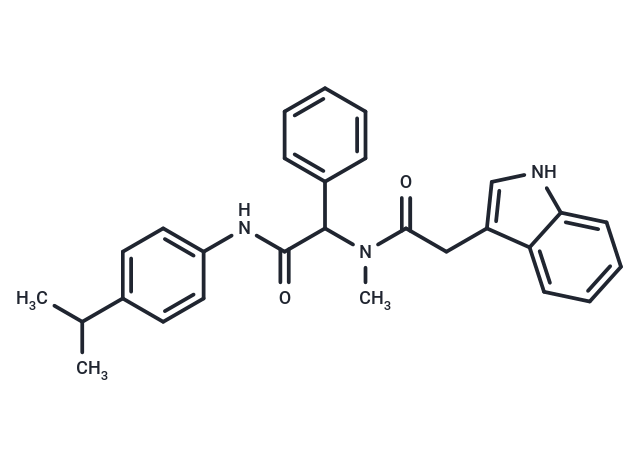Shopping Cart
- Remove All
 Your shopping cart is currently empty
Your shopping cart is currently empty

PG01 is a potent CFTR Cl-channel potentiator, effective against ΔF508 (Ka 0.3 μM), and also against E193K, G970R and G551D (CFTR mutants), with Kd values of 0.22 μM, 0.45 μM and 1.94 μM, respectively.PG01 increases ΔF508-CFTR Cl- currents upon addition of forskolin. F508-CFTR Cl-current upon addition of Forskolin, correcting the gating defect of CFTR mutants.

| Pack Size | Price | Availability | Quantity |
|---|---|---|---|
| 1 mg | $76 | In Stock | |
| 5 mg | $227 | In Stock | |
| 10 mg | $341 | In Stock | |
| 25 mg | $548 | In Stock | |
| 50 mg | $738 | In Stock | |
| 100 mg | $1,000 | In Stock | |
| 200 mg | $1,350 | In Stock | |
| 1 mL x 10 mM (in DMSO) | $221 | In Stock |
| Description | PG01 is a potent CFTR Cl-channel potentiator, effective against ΔF508 (Ka 0.3 μM), and also against E193K, G970R and G551D (CFTR mutants), with Kd values of 0.22 μM, 0.45 μM and 1.94 μM, respectively.PG01 increases ΔF508-CFTR Cl- currents upon addition of forskolin. F508-CFTR Cl-current upon addition of Forskolin, correcting the gating defect of CFTR mutants. |
| Targets&IC50 | CFTR (G551D):1.94 μM(Kd), G970R:0.45 μM(Kd), E193K:0.22 μM(Kd) |
| In vitro | PG01 induces significant currents in cells expressing either G551D- or G1349D-CFTR. While PG01 alone does not activate ∆F508-CFTR, it notably enhances ∆F508-CFTR Cl- current in the presence of Forskolin (0.5 and 2 μM). At a concentration of 100 nM, PG01 markedly increases channel activity, evidenced by frequent channel openings. The compound's effectiveness in activating G551D-CFTR, with an apparent Kd of 1 μM, is roughly 100 times greater than that of genistein, and its potency in activating G1349D-CFTR is superior, requiring only 40 nM. These currents are blocked by CFTRinh-172 and absent in nontransfected cells, indicating specificity for CFTR modulation.[1] |
| In vivo | Microsome metabolism studies and rat pharmacokinetic analysis indicate that PG01 metabolizes significantly faster than SF-03. The pharmacokinetics of PG01 in rats were assessed through serial plasma concentration measurements following single bolus infusions (5 mg/kg), revealing that its pharmacokinetics adhere to a two-compartment model with elimination half-times of less than 5 minutes and 130 minutes, and a distribution volume of 4 L.[1] |
| Alias | Phenylglycine-01 |
| Molecular Weight | 439.55 |
| Formula | C28H29N3O2 |
| Cas No. | 853138-65-5 |
| Smiles | CC(C)c1ccc(NC(=O)C(N(C)C(=O)Cc2c[nH]c3ccccc23)c2ccccc2)cc1 |
| Relative Density. | 1.217g/cm3 |
| Storage | Powder: -20°C for 3 years | In solvent: -80°C for 1 year | Shipping with blue ice. | ||||||||||||||||||||||||||||||
| Solubility Information | DMSO: 30 mg/mL (68.25 mM), Sonication is recommended. | ||||||||||||||||||||||||||||||
Solution Preparation Table | |||||||||||||||||||||||||||||||
DMSO
| |||||||||||||||||||||||||||||||

Copyright © 2015-2025 TargetMol Chemicals Inc. All Rights Reserved.